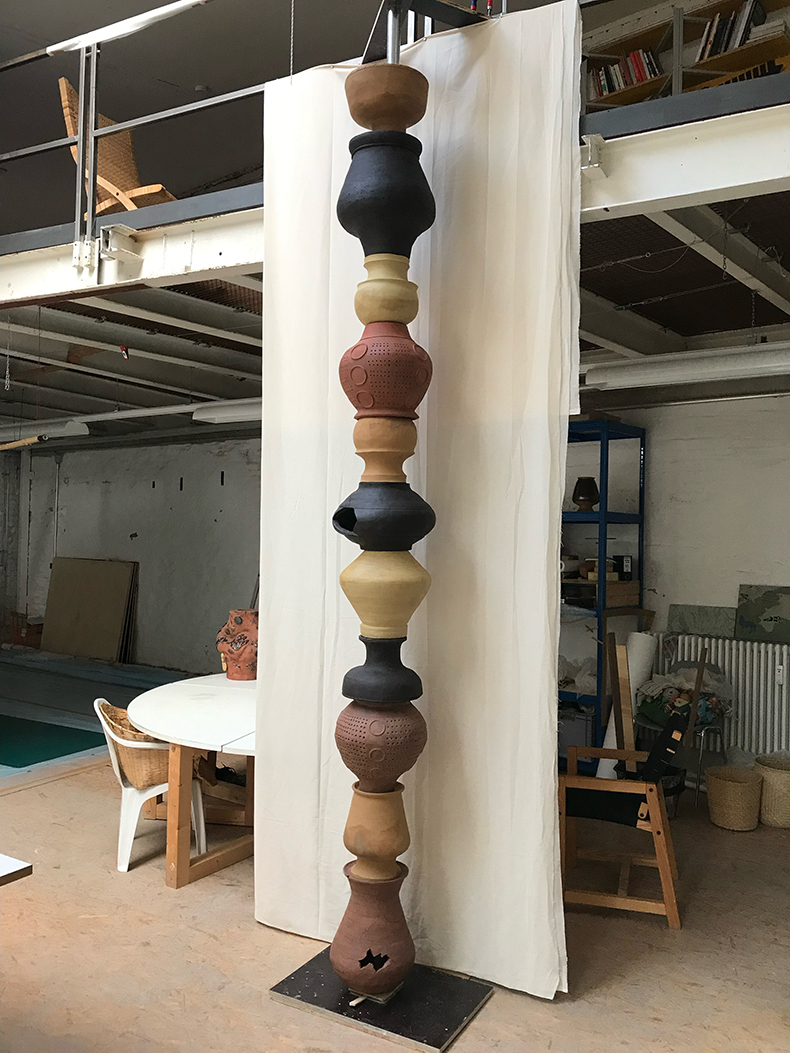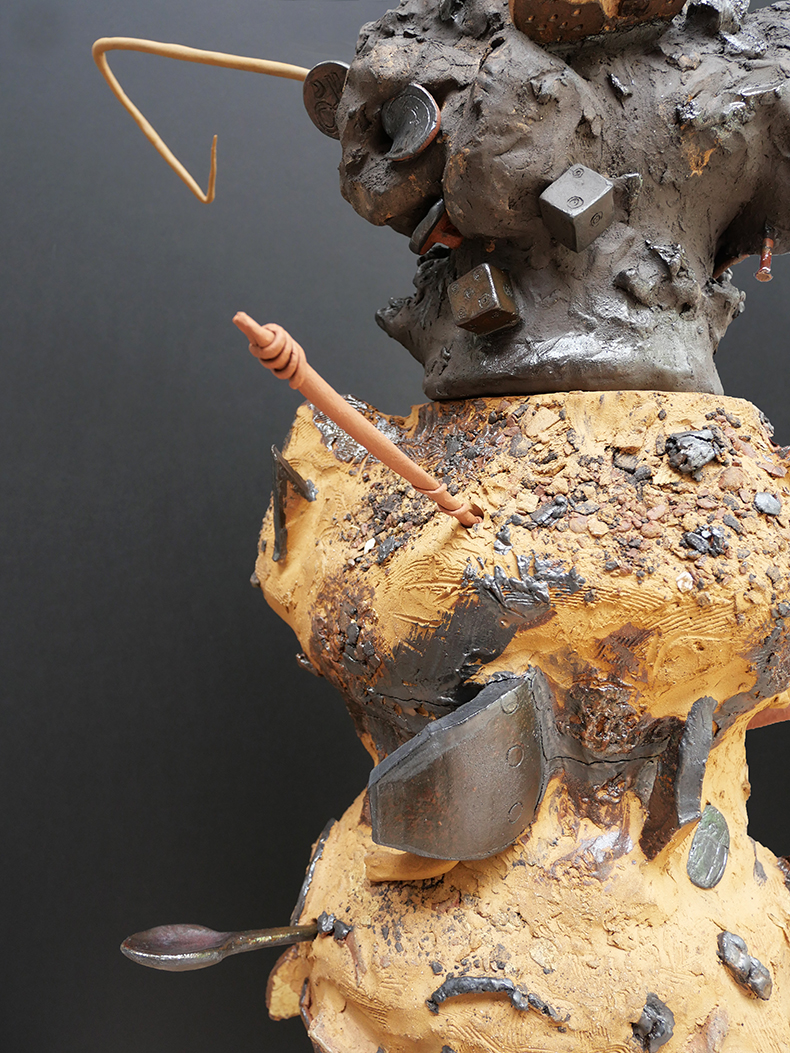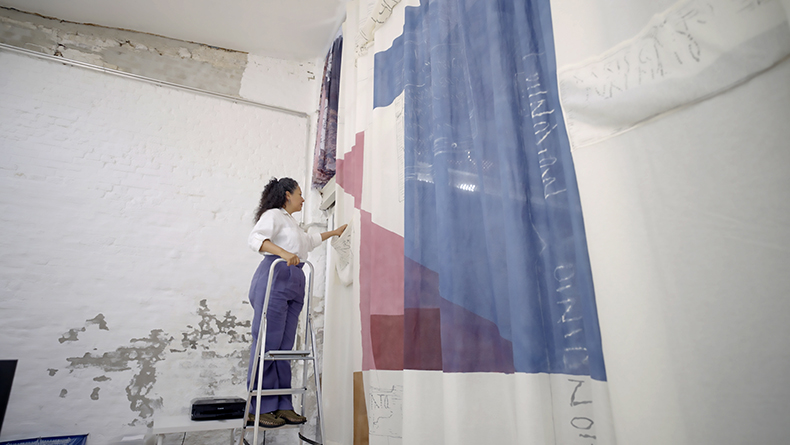The Mexican artist Mariana Castillo Deball works across a wide range of mediums, including installation, performance and sculpture, to explore the ways in which objects shape our identity and history. Her practice is rooted in research and often involves collaboration with ethnographic collections, libraries and archives. Her most recent installation, ‘Roman Rubbish’, comprises ceramic sculptures, a textile curtain and a wax wall with inscriptions. A commission for Bloomberg SPACE at the London Mithraeum, where it is on view until 14 January 2023, the work has been inspired by the 14,000 Roman artefacts that were discovered on the site of Bloomberg’s European headquarters during archaeological excavations in 2012.
Where is your studio?
My studio is in Berlin. It used to be a wood workshop, I believe, and before me, it was occupied by a group of women who were working on scenography for the theatre.
What do you like most about the space?
I like that it’s very quiet because it’s right next to a park. It’s also quite a flexible space. I am able to adapt it for my different projects and the mediums that I am using: sometimes I am making ceramics or wood cuts; at other times I’m doing carpentry or working with textiles. It’s not big enough for me to do all of those things simultaneously but I can create different areas within the space. The light in the studio is also very beautiful. Upstairs I have a library where I can draw. Drawing is an important part of my practice; it’s quite an intimate process for me so I like to have a smaller space to work in.
Is there anything that frustrates you about it?
No, I really love it. Nothing to complain about at all.

Works in progress for Roman Rubbish, in the artist’s studio. Photo: © Mariana Castillo Deball
Do you work alone?
Sometimes, but I also have three people who help me in the studio. They come two days a week. One is a specialist in ceramics, one is a specialist in carpentry and the other person helps with budgets and the overview of the project. I teach in another city in Germany which means I’m always away from my studio on Mondays and Tuesdays.
When you’re in the studio, do you like to follow a particular routine?
It depends what I’m working on. I don’t relate to the kind of artist who needs to have inspiration to find out what to do next. I cannot remember a moment when I was sitting at my desk thinking, ‘What shall I do now?’ My processes are very long and one thing tends to lead to another. I might speculate on how to use another material, for example, as my work is very much divided between material investigations – how to do things – and the provenance of these materials in relation to museums, archives or public spaces. My studio practice is not only based on what I create in the studio, but also on the encounters I have in other spaces.
What’s the most well-thumbed book in your library?
I have a collection of Mexican manuscripts. There is one that is called Codex Borgia, which I have used for many different projects. One section is a facsimile and the other section is an interpretation of the drawings. The book belonged to my father so it has a long history and I return to it often. I’m not sure that I will ever be able to understand it fully.

Detail of a work from Roman Rubbish. Photo: © Mariana Castillo Deball
What’s the most unusual object in your studio?
I collect a lot of very small things, or fragments of things which are completely useless. They don’t really have any aesthetic value. They’re basically rubbish, but they have a sentimental value to me. I pick them up when I’m travelling or installing shows: bits of ceramic that have fallen off a work, pieces of metal.
Where are they kept?
All over the place!
Do you pin up work by other artists?
Not really, but I create folders with print-outs of reference images for each project; a lot of that visual material comes from other artists. I find it in books, and scan it, before printing it out in a very quick, cheap way, usually in black and white. The folders are kept in my archive so if I need to look back at something I can easily find it. If it were stored on the computer, it would disappear into the chaos of files and data, so this is how I have to do things.

© Next Shoot Ltd
Which artistic tool could you least do without?
I have a collection of bones which are used to fold paper, or to open letters. I work a lot with paper and create models for shows. I have been using these bones for more than 20 years. I always have one with me whenever I go somewhere to install a show. It’s a humble tool.
Who’s the most interesting visitor you’ve had to the studio?
Well, for a while, I was working on a technique called scagliola. There are very few people who can still do it but there was a person who came to give us a workshop in the studio and to share his knowledge. That was very special. His way of working is less to do with measurements and more to do with a feeling for how the material should look. It was very interesting for me. So much of craft knowledge is not written down and it was special to see how he carried this knowledge with him, in his body.
‘Mariana Castillo Deball: Roman Rubbish’ is at London Mithraeum Bloomberg SPACE from 4 August to 14 January 2023.














![Masterpiece [Re]discovery 2022. Photo: Ben Fisher Photography, courtesy of Masterpiece London](http://zephr.apollo-magazine.com/wp-content/uploads/2022/07/MPL2022_4263.jpg)
‘Like landscape, his objects seem to breathe’: Gordon Baldwin (1932–2025)